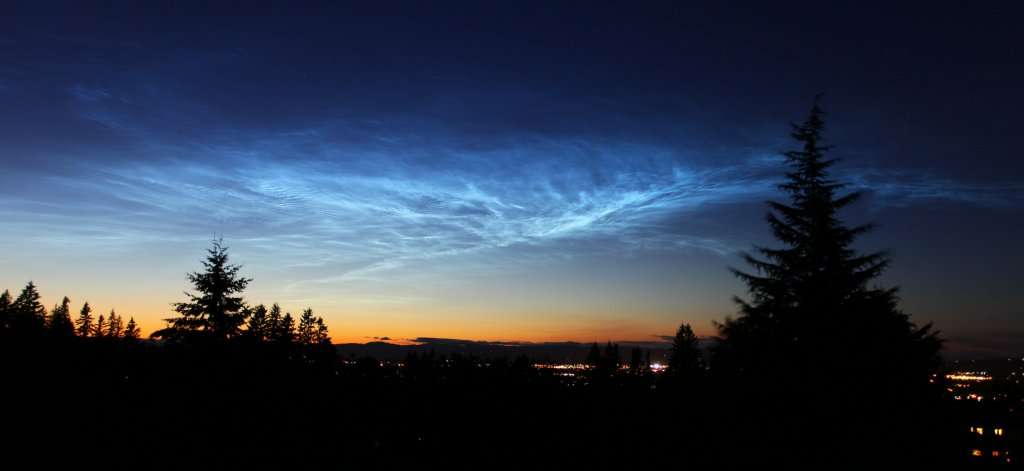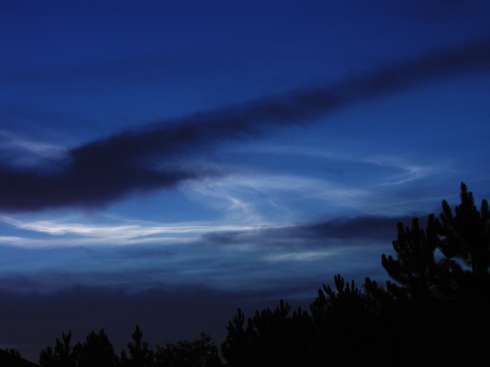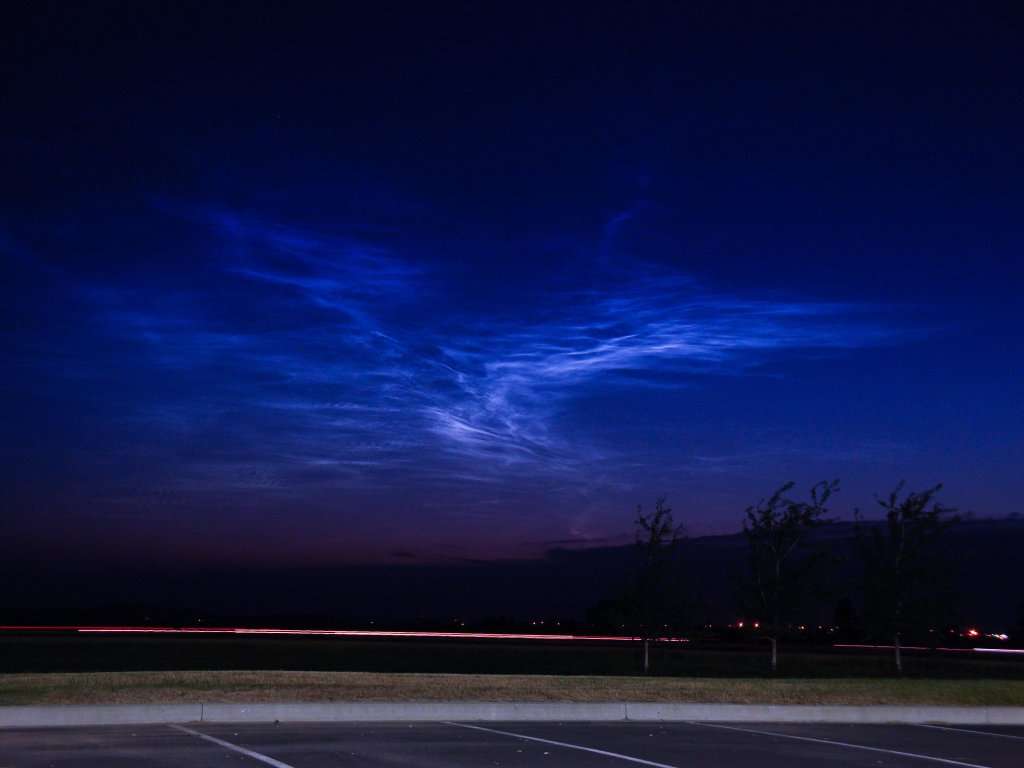(noon. – promoted by ek hornbeck)

Photo By VinceVarnas, Oregon FishOutofWater
Electric blue clouds, literally at the edge of space, have been recently seen glowing in the dark from Oregon to Colorado to Virginia, further south than they have ever been seen. Noctilucent clouds were first reported in the far north after the Krakatoa eruption. Until the last several decades they were always seen north of 50 N Latitude. No one is sure why the clouds are moving south but global warming is a suspected cause.

By NASA FishOutofWater
Noctilucent clouds form at exceedingly cold temperatures around negative 125 Celsius, 50 to 100km (30 to 60 miles) above the earth’s surface, in the mesosphere. The atmosphere is one hundred million times drier than the Sahara desert, but clouds form because the temperature is so low. They are seen in midsummer when the moisture from the stratosphere (the layer below the mesosphere) is known to upwell into the mesosphere. One other likely source of water is upwelling methane gas. Methane is broken down by UV and high energy radiation to generate hydrogen gas which reacts with oxygen to form water. Material from incoming meteors may also add both tiny particles needed to seed the clouds and ice particles which vaporize. Powerful volcanic eruptions may also add particles that nucleate ice.

By VictorVonSalsa Portland, Oregon 15July09 FishOutofWater
Space shuttle launches produce enough water in the high atmosphere to create noctilucent clouds. The recent space shuttle launch generated ultra-high clouds that were seen in Florida.

By Martin Zloty, 17July09, Florida Space Shuttle NLC FishOutofWater
Astronaut Don Pettit, who worked as a staff scientist at Los Alamos National Laboratory studied noctilucent clouds seeded by high-flying sounding rockets. He talked about NLC’s on NASA TV.
Ordinary clouds, which are close to Earth, get their dust from sources like desert wind storms. It’s hard to waft wind-blown dust all the way up to the mesosphere, however. “Krakatoa may have seeded the mesosphere with dust in 1883, but that doesn’t explain the clouds we see now,” notes Thomas. “Perhaps the source is space itself,” he speculates. Every day Earth sweeps up tons of meteoroids–tiny bits of debris from comets and asteroids. Most are just the right size to seed noctilucent clouds.
The source of water vapor is less controversial. “Upwelling winds in the summertime carry water vapor from the moist lower atmosphere toward the mesosphere,” says Thomas. This is why NLCs appear during summer.
One reason for the recent spread of noctilucent clouds might be global warming. “Extreme cold is required to form ice in a dry environment like the mesosphere,” says Thomas. Ironically, global warming helps. While greenhouse gases warm Earth’s surface, they actually lower temperatures in the high atmosphere. Thomas notes that noctilucent clouds were first spotted during the Industrial Revolution – a time of rising greenhouse gas production.
The unique signature of greenhouse gas caused warming, is cooling of the stratosphere and mesosphere. Increasing levels of greenhouse gasses lower the temperature of thermal radiation escaping the lower atmosphere so that the upper atmosphere cools.
All types of warming that don’t involve the greenhouse effect warm the whole atmosphere. Solar warming and warming caused by changing ocean currents (El Nino)warm the upper atmosphere as well as the lower atmosphere. Heat radiating upwards from the earth and lower atmosphere warms the upper layers of the atmosphere when surface warming happens because of solar cycle or ocean current caused warming . Noctilucent clouds would not increase if the sun were warming. Noctilucent clouds are most frequently seen around the solar minimum when because solar heating of the upper atmosphere is at a minimum.

By Brian-Chilcoat, Spokane Washington 23July09 FishOutofWater
Arctic clouds appearing in the midlatitudes are a beautiful sign of climate change.

5 comments
Skip to comment form
I really like your work, fish out of water. Glad to see you posting on DD.
Hopefully you will hang out here more often.
Hopefully we’ll have better matters to discuss, too.
Cheers
strange cloud formations lately.
Another common one I see quite frequently are cumulus clouds framed against a silver sky. Wait a minute, aren’t cumulus clouds supposed to be fair weather clouds? Why aren’t the skies deep blue any more?